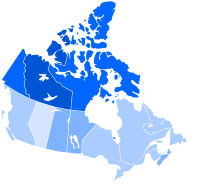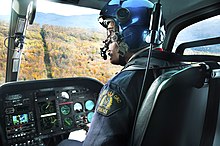Law enforcement in Canada
This article needs additional citations for verification. (September 2017) |

Law enforcement in Canada consists of public-sector police forces that are associated with and commissioned to the three levels of government: municipal (both lower and upper-tier), provincial, and federal. In addition, many First Nations reserves have their own police forces established through agreements between the governing native band, province and the federal government.[citation needed] Most urban areas have been given the authority by the provinces to maintain their own police forces. Seven of Canada's provinces and all three territories, in turn, contract out their provincial or territorial law-enforcement responsibilities to the Royal Canadian Mounted Police (RCMP, popularly known in English-speaking areas as the "Mounties"), the national police force, which is commissioned to the federal level of government; the other three maintain provincial police forces, although one also partially contracts out to the RCMP. The Canada Border Services Agency (CBSA) is the second largest law enforcement agency in Canada. The CBSA facilitates the flow of legitimate travellers and trade. The agency also enforces more than 90 acts and regulations. Since December 2003, the CBSA has been an integral part of the Public Safety Portfolio.[citation needed] The president of the CBSA reports directly to the Minister of Public Safety Canada and controls and manages all matters relating to the agency
Police services[]

The provinces of Ontario, Quebec, and Newfoundland and Labrador maintain their own provincial police service, Ontario Provincial Police, Sûreté du Québec, and Royal Newfoundland Constabulary. Smaller municipalities often contract police services from the provincial policing authority, while larger ones maintain their own services. Newfoundland's provincial police service is only responsible for the province's larger urban areas (St. John's, Corner Brook, and Labrador West); the province has contracted the RCMP to patrol the rest of the province. The other seven provinces and the three territories contract police services to the RCMP. It also serves as the local police in all areas outside of Ontario and Quebec that do not have an established local police service, mostly in rural areas. Thus, the RCMP is the only police service of any sort in some areas of the country.
There are also a few private police services with some of the powers usually reserved for governmental forces (as it relates to company property). The Canadian National Railway, Canadian Pacific Railway, and Via Rail each have their own police service (CN Police, Canadian Pacific Police Service, and Via Rail Police[1][2]). Any railway in Canada, under federal jurisdiction, can request that a superior court judge appoint police officers under the Railway Safety Act.[3] The duties of private railway police are to prevent crimes against the company and protection of goods, materials, and public rail transit being moved on their rail systems. They work to protect the public, rail personnel, and property owned or administered by the railways. The regular public police maintain authority and jurisdiction for all criminal offences, regardless of whether the offence occurs on public or private property. Some hospitals, universities, transit commissions, power authorities and other agencies employ special constables or in other provinces known as peace officers. The local police chief has statutory and common law authority and responsibility for the jurisdiction policed. The duties of peace officers are determined by their employers and have authorities limited by statutes under which they operate. All persons and companies have access to public police.
Canadian Forces Military Police[]
The Canadian Forces Military Police (CFMP) contribute to the effectiveness and readiness of the Canadian Armed Forces (CAF) and the Department of National Defence (DND) through the provision of professional police, security, and operational support services worldwide.[4]
The CFMP are classified as peace officers in the criminal code,[5] which gives them powers, similar to civilian law enforcement personnel, to enforce some Acts of Parliament on or in relation to DND property or assets anywhere in the world. The National Defence Act (NDA) does not bestow the authority to the minister of defence to appoint police officers. Section 156(1) of the National Defence Act does allow the minister to confer limited peace officer status to specially appointed military police members. They have the power to arrest anyone who is subject to the Code of Service Discipline (CSD), regardless of position or rank under the NDA. MP have the power to arrest and charge non-CSD bound civilians only in cases where a crime is committed on or in relation to DND property or assets, or at the request of the minister of public safety, Commissioner of the Correctional Service of Canada or Commissioner of the Royal Canadian Mounted Police. Although MP jurisdiction is only on DND property across Canada and throughout the world, any civilian accessing these areas falls under MP jurisdiction and are dealt with in the same manner as any civilian policing agency. If in fact a crime is committed on or in relation to DND property or assets, MP have the power to arrest and charge the offender, military or civilian, under the criminal code.[6][7] MP also have the power to enforce the Provincial Highway Traffic Act on some military bases in Canada.
Strength[]

In 2019, there were 100,417 active/sworn police officers in Canada.
Canadian police strength reached a peak in 1975, when there were 206 officers per 100,000 people. Although the current number reflects a significant rise in the total police strength in the country (the highest in twelve years after steady declines in the 1980s and 1990s), Canada still utilizes fewer police than Wales (262/ 100,000).
Provincially, Nova Scotia had the highest number at 193.8 officers per 100,000. The lowest numbers were in Prince Edward Island and New Brunswick.[9] The three territories, while having far fewer police officers in absolute terms, have around twice as many police officers per capita as do the provinces.
| Annual Rate: Police Officers per 100,000 Population | ||||||||||||||||
| 2003 | 2004 | 2005 | 2006 | 2007 | 2008 | 2009 | 2010 | 2011 | 2012 | 2013 | 2014 | 2015 | 2016 | 2017 | 2018 | |
|---|---|---|---|---|---|---|---|---|---|---|---|---|---|---|---|---|
| Canada | 187.8 | 187.2 | 189.3 | 191.8 | 195.0 | 196.4 | 200.0 | 203.1 | 202.2 | 200.2 | 197.4 | 194.2 | 192.6 | 190.7 | 188.9 | 185.0 |
| Newfoundland and Labrador | 148.1 | 148.0 | 150.9 | 156.5 | 164.6 | 172.8 | 177.5 | 179.9 | 178.1 | 175.9 | 174.0 | 169.5 | 168.3 | 171.9 | 172.4 | 171.3 |
| Prince Edward Island | 158.9 | 150.4 | 154.3 | 159.6 | 164.8 | 166.5 | 167.3 | 168.0 | 169.5 | 170.9 | 161.0 | 163.6 | 156.4 | 154.5 | 147.4 | 141.0 |
| Nova Scotia | 171.5 | 171.9 | 173.1 | 177.7 | 188.0 | 199.2 | 200.1 | 203.0 | 202.7 | 205.0 | 201.5 | 200.7 | 198.1 | 193.3 | 192.6 | 193.8 |
| New Brunswick | 170.8 | 173.7 | 173.4 | 173.1 | 177.9 | 181.4 | 181.9 | 185.6 | 182.2 | 179.9 | 177.2 | 170.0 | 168.4 | 168.3 | 160.9 | 159.5 |
| Quebec | 192.0 | 191.4 | 194.6 | 197.8 | 198.0 | 198.5 | 198.0 | 196.6 | 197.4 | 198.2 | 197.3 | 198.7 | 195.9 | 194.0 | 191.4 | 189.3 |
| Ontario | 189.8 | 187.4 | 186.9 | 187.6 | 191.6 | 193.6 | 196.6 | 200.3 | 199.0 | 196.1 | 195.1 | 192.0 | 191.2 | 188.6 | 184.6 | 176.8 |
| Manitoba | 195.7 | 193.1 | 191.5 | 195.4 | 202.5 | 202.0 | 206.6 | 208.8 | 210.2 | 216.5 | 212.8 | 206.9 | 201.4 | 194.7 | 192.6 | 188.7 |
| Saskatchewan | 200.4 | 201.5 | 202.4 | 204.6 | 204.2 | 208.8 | 206.3 | 218.9 | 216.3 | 212.0 | 209.7 | 206.1 | 203.9 | 202.6 | 203.3 | 186.4 |
| Alberta | 157.0 | 158.1 | 160.6 | 163.8 | 162.3 | 159.5 | 168.5 | 177.0 | 176.7 | 175.2 | 173.3 | 171.2 | 172.6 | 174.3 | 176.3 | 174.4 |
| British Columbia | 172.4 | 170.2 | 177.4 | 181.0 | 188.2 | 187.0 | 195.6 | 198.4 | 198.8 | 194.6 | 191.3 | 184.2 | 181.6 | 180.3 | 182.1 | 185.2 |
| Yukon | 400.5 | 384.5 | 376.1 | 359.5 | 365.5 | 353.6 | 361.7 | 349.8 | 344.5 | 328.4 | 361.4 | 363.5 | 344.9 | 358.0 | 323.0 | 326.1 |
| Northwest Territories | 383.0 | 394.9 | 398.6 | 396.0 | 403.5 | 410.6 | 454.2 | 466.7 | 452.8 | 455.9 | 438.3 | 437.5 | 454.4 | 445.7 | 407.2 | 416.5 |
| Nunavut | 412.7 | 412.0 | 399.0 | 395.9 | 391.8 | 373.1 | 383.4 | 395.8 | 380.2 | 360.5 | 362.2 | 330.8 | 359.0 | 354.3 | 356.8 | 354.2 |
| Notes: Represents actual police officer strength as of June 15 up to 2005; and as of May 15 since 2006. Total for Canada includes police officers in the Royal Canadian Mounted Police headquarters, training academy depot division and forensic labs; these are excluded from provincial/territorial totals. | ||||||||||||||||
Police service ranks[]

The Chief of Police is the title of the head of most Canadian police forces except for the Royal Canadian Mounted Police (Commissioner), Ontario Provincial Police (Commissioner), South Coast British Columbia Transportation Authority Police Service (Chief Officer), Vancouver Police Department (Chief Constable), West Vancouver Police Department (Chief Constable), Nelson Police Department (Chief Constable) and the Sûreté du Québec (Director General). Other typical ranks include:
- Deputy Chief of Police
- Chief Superintendent
- Staff Superintendent (and Senior Staff Superintendent)
- Superintendent
- Staff Inspector
- Inspector
- Sergeant Major
- Staff Sergeant (and Detective Sergeant)
- Sergeant (and Detective)
- Corporal (and Detective Corporal)
- Senior Constable
- Police Constable (and Detective Constable)
- Ranking also exists (i.e. 1st Class Constable, 2nd Class Constable, etc...)
- Special Constable
- Cadet/Recruit
Use of force options[]
This article's section named "Weapons" needs additional citations for verification. (May 2008) |

In the 1990s, the majority of law enforcement agencies of Canada began wearing bulletproof vests and municipal police agencies started carrying semi-automatic handguns in the .40 S&W calibre cartridge. In terms of numbers of officers, and due to its use by the Royal Canadian Mounted Police, the most widely used weapon is the Smith & Wesson Model 5946 with hollow-point 9mm ammunition. A large number of other agencies issue either a Glock or SIG Sauer handgun (most commonly in the law-enforcement popular .40 S&W).
These firearms replaced the aging .38 Special revolver. A police cruiser might carry a carbine rifle; or a shotgun capable of firing a variety of shotgun shells, including the less-lethal flexible baton round and rubber bullets.
Other less-lethal weapons carried include tasers, pepper spray, and an expandable baton. In addition, the personal equipment of police officers typically includes: handcuffs, flashlight, portable radio, notebook, pens, a pair of disposable gloves and Kevlar gloves.
See also[]
|
|
References[]
- ^ "Rail Policing Security". VIA Rail. 8 May 2014.
- ^ "VIAP Police Job Description" (PDF).
- ^ Branch, Legislative Services. "Consolidated federal laws of canada, Railway Safety Act". laws-lois.justice.gc.ca.
- ^ "Archived copy". Archived from the original on 2012-02-23. Retrieved 2012-04-29.CS1 maint: archived copy as title (link)
- ^ Section 2 Criminal Code of Canada
- ^ "GOVERNANCE OF THE CANADIAN FORCES MILITARY POLICE (P.32)" (PDF).
- ^ "Military Police Powers - DriveSmartBC". drivesmartbc.ca.
- ^ "Police officers by level of policing, by province and territory, 2012" (PDF). Statistics Canada. Retrieved 2014-03-03.
- ^ Jump up to: a b Statistics Canada, Table 35-10-0076-01—Police personnel and selected crime statistics, doi:10.25318/3510007601-eng.
- Law enforcement in Canada
